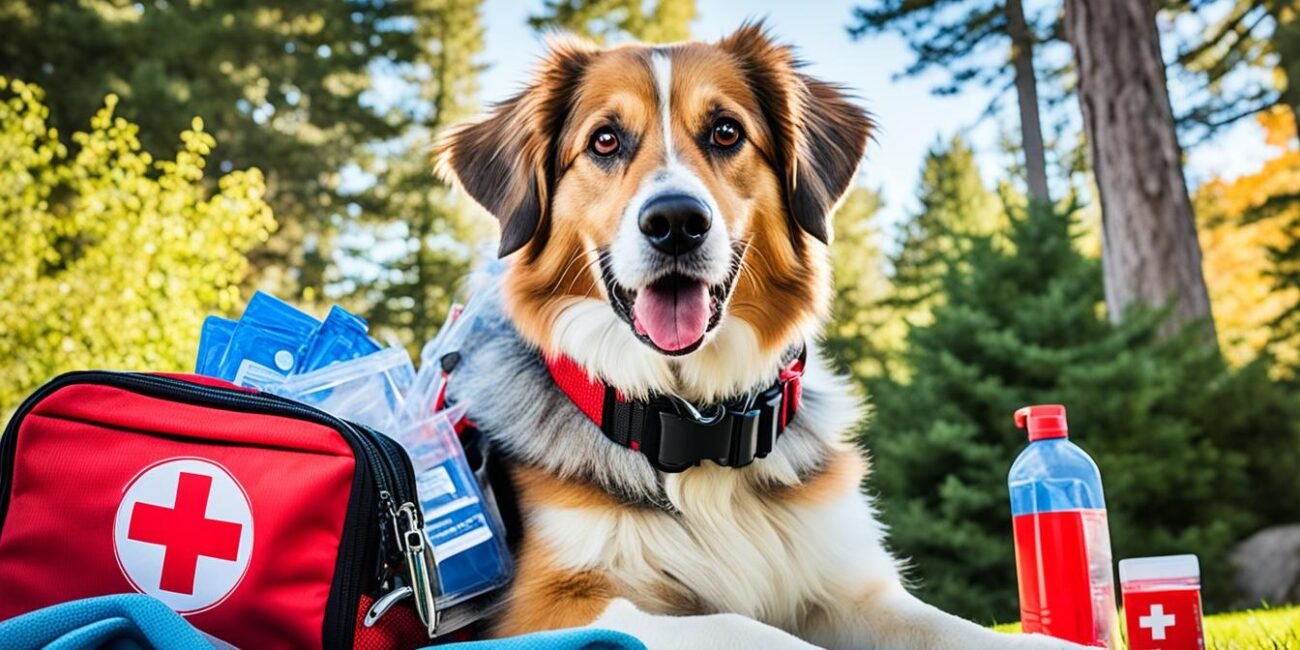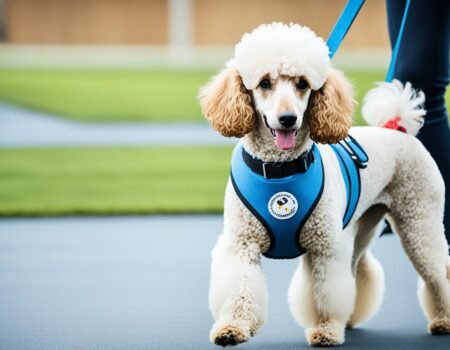In times of emergencies, your furry friends rely on you to keep them safe. Being prepared and having a plan in place is crucial to ensure the well-being of your dog during unexpected events. This quick safety guide will provide you with essential tips and information on dog emergency preparedness, so you can be ready to act swiftly and effectively when needed.
Key Takeaways:
- Create an emergency plan for your dog, including evacuation procedures and a buddy system.
- Build an emergency kit with essential supplies such as food, water, medicine, and a first aid kit.
- Make sure your dog has proper identification, such as a collar with an ID tag and a microchip.
- Stay informed about local emergency alerts and follow the instructions of local officials.
- Plan for your pet’s safety in various situations, including finding pet-friendly accommodations.
Make a Plan for Your Dog’s Safety
Hurricanes, floods, fires, and other emergencies can strike without warning. It is crucial to have a comprehensive plan in place to ensure the safety and well-being of your beloved dog. By making a plan, you can minimize the stress and uncertainty during these challenging times.
Here are some key steps to include in your dog’s emergency plan:
Develop an Evacuation Plan for Your Pet
Identify safe locations where you and your dog can seek shelter in the event of an emergency. Research pet-friendly hotels or shelters along your evacuation route. Create a checklist of essential items to pack for your dog, including food, water, medication, bedding, and any comfort toys or blankets.
Establish a Buddy System
Reach out to friends, neighbors, or family members who can assist you during an emergency. Establish a buddy system where you can rely on each other’s support, such as exchanging keys to each other’s homes or helping each other evacuate if needed. Having someone you trust to care for your dog in case you are unable to can provide peace of mind.
Microchip Your Pet
Microchipping your pet is crucial for their identification in case they get lost during an emergency. Ensure your dog’s microchip information is up-to-date with your current contact details. In the event of separation, a microchip greatly increases the chances of being reunited with your furry friend.
Contact Your Local Emergency Management Office
Reach out to your local emergency management office to familiarize yourself with their guidelines and recommendations for pet safety during emergencies. They can provide valuable information about available resources, emergency shelters, and any specific regulations regarding the evacuation of pets in your area.
Remember that emergencies can be unpredictable, and having a plan in place will help you navigate these challenging situations more effectively. Your furry companion’s safety and well-being are in your hands.
| Key Steps | Details |
|---|---|
| Develop an Evacuation Plan for Your Pet | Identify safe locations, research pet-friendly accommodations, and create a checklist of essential items to pack for your dog. |
| Establish a Buddy System | Reach out to friends, neighbors, or family members who can assist you and exchange keys or evacuation plans. |
| Microchip Your Pet | Ensure your dog’s microchip information is up-to-date to increase the chances of being reunited if lost. |
| Contact Your Local Emergency Management Office | Familiarize yourself with their guidelines and recommendations for pet safety during emergencies. |
Build an Emergency Kit for Your Dog
When it comes to preparing for emergencies, don’t forget about your furry friend. Building an emergency kit for your dog is crucial to ensure their well-being and safety during unexpected situations.
Gather the Essentials
Start by gathering the essential items that your dog will need in case of an emergency. Here are some key items to include in your dog’s emergency kit:
- Food and Water: Pack enough food and water to last your dog for at least three days. Store these in airtight, waterproof containers to keep them fresh.
- Medicine: If your dog requires any medication, make sure to have a supply for several days. Remember to rotate these medications periodically to ensure they don’t expire.
- First Aid Kit: Put together a first aid kit specifically for your dog. Include items such as bandages, antiseptic solution, tweezers, and any necessary prescribed medications.
- Collar and ID Tag: Ensure your dog wears a collar with an up-to-date ID tag at all times. In case you get separated during an emergency, this will increase the chances of being reunited.
- Travel Carrier: Have a sturdy travel carrier or crate ready in case you need to evacuate with your dog. Make sure it’s big enough for your dog to comfortably stand, turn around, and lie down in.
- Grooming Items: Pack grooming items such as a brush, leash, poop bags, and any other grooming supplies specific to your dog’s breed or needs.
- Sanitation Needs: Don’t forget to include items for your dog’s sanitation needs, such as pee pads, litter, or a portable pet toilet.
- Familiar Items: Include a few familiar items in the kit, such as their favorite toy or blanket, to help reduce stress and provide comfort in unfamiliar situations.
Remember to assess your dog’s emergency kit regularly and update any expired items or adjust it according to your dog’s changing needs. Additionally, consider adding any extra items that are specific to your dog’s health or habits.
Making sure your dog’s needs are taken care of during emergencies is an important part of being a responsible pet owner. With a well-prepared emergency kit, you can ensure your dog’s safety and comfort, no matter the circumstances.
Tips for Large Animals
If you have large animals on your property, such as horses or goats, it is crucial to have specific plans in place for their safety during emergencies. Large animals require special considerations and preparations to ensure their well-being. Here are some important tips to help you create an effective emergency plan:
- Ensure Identification: Always ensure that your large animals have proper identification. This can include using visible tags, microchipping, or branding. In case of separation during an emergency, identification will greatly increase the chances of reuniting with your animals.
- Map Out Evacuation Routes: Plan and map out evacuation routes in advance. Identify safe areas or facilities where you can move your large animals during emergencies. Be familiar with alternative routes, avoiding any potential roadblocks or unsafe areas.
- Prepare Transportation: Have appropriate vehicles and trailers ready for transportation. Regularly maintain and check them to ensure they are in good working condition. Practice loading and unloading your large animals so they become accustomed to the process in case of an actual emergency.
- Decide to Move or Leave: Make a clear decision regarding whether to move your large animals or leave them in a safe area. Consult with local authorities and follow their guidance. Consider factors such as the severity of the emergency, the availability of suitable shelter, and the proximity of safe destinations.
By taking these precautions and making plans in advance, you can minimize the risks and ensure the safety of your large animals during emergencies.
Stay Informed during Emergencies
During emergencies, staying informed about current conditions and following instructions is crucial for the safety of both you and your pets. By staying updated, you can make informed decisions to protect yourself and your furry companions.
Here are some key steps to help you stay informed:
- Wireless Emergency Alerts: Pay attention to wireless emergency alerts issued by local authorities. These alerts provide important information and instructions regarding the emergency situation.
- Listen to Local Officials: Stay tuned to local news and radio stations for updates and instructions from local officials. They will provide guidance on evacuation routes, temporary shelters, and other essential information.
- Download the FEMA App: The FEMA app is a valuable resource for emergency preparedness. It provides real-time weather alerts, emergency safety tips, and information about disaster assistance available in your area.
- Bringing Pets Indoors: When you receive the first sign of a storm or disaster, bring your pets indoors to keep them safe and secure. This will help protect them from potential harm caused by extreme weather conditions.
By following these steps and staying informed, you can ensure that you and your pets are well-prepared and protected during emergencies.
| Stay Informed during Emergencies | Key Steps |
|---|---|
| Wireless Emergency Alerts | Pay attention to wireless emergency alerts issued by local authorities. |
| Listen to Local Officials | Stay tuned to local news and radio stations for updates and instructions from local officials. |
| Download the FEMA App | Download the FEMA app for real-time weather alerts and valuable emergency information. |
| Bringing Pets Indoors | Bring your pets indoors at the first sign of a storm or disaster to keep them safe. |
Plan for Your Pets in Various Situations
Planning for your pets in different situations is crucial for their safety and well-being. By taking proactive steps, you can ensure that your furry friends are protected and cared for during emergencies. Here are some essential elements to consider:
Microchipping
Microchipping your pets is a simple yet effective way to increase the chances of reuniting with them if they get lost during an emergency. A tiny microchip, about the size of a grain of rice, is implanted under your pet’s skin. It contains a unique identification code that can be scanned by veterinarians and shelters. Remember to keep your contact information up to date so you can be easily reached.
Establishing a Backup Caretaker
In case you are unable to care for your pets during an emergency, it’s crucial to have a backup caretaker lined up. This individual should be someone you trust and who is familiar with your pets’ needs. Make sure to provide them with detailed instructions on feeding, medication, and any other specific requirements your pets may have.
Keeping Vaccination Records Handy
During emergencies, keeping your pets’ vaccination records readily accessible can be beneficial. Vaccinations help protect them from common diseases and ensure their overall health. Having these records on hand can be important if you need to seek shelter or board your pets temporarily.
Researching Pet-Friendly Accommodations
When emergencies strike, it’s essential to have a list of pet-friendly accommodations. Not all shelters or hotels accept pets, so researching in advance can save you time and stress. Look for establishments that not only allow pets but also provide suitable facilities and amenities to ensure your pets’ comfort.
Listing Boarding Facilities and Veterinary Offices
In some situations, it may be safer for your pets to stay in a boarding facility or with a veterinary office. Prepare a list that includes nearby boarding facilities and veterinary offices that can provide shelter during emergencies. Make sure to contact them in advance to inquire about availability and any specific requirements they may have.
By implementing these measures, you can create a comprehensive plan for your pets’ safety and well-being during various situations. It’s important to remember that each pet is unique, so tailor your preparations to meet their specific needs.
“Taking the time to plan for your pets’ safety can mean the difference between them being protected or exposed to unnecessary risks during emergencies.”
Make a Disaster Kit for Your Pet
Having a well-prepared disaster kit for your pet is crucial to ensure their comfort and care during emergencies. Your pet relies on you for their safety and well-being, and a properly stocked disaster kit will help you meet their needs when disaster strikes.
Food and Water
- Pack at least three days’ worth of your pet’s regular food in a waterproof container.
- Store fresh water in sturdy containers.
- Include collapsible bowls for feeding and drinking.
Medications
- Include a supply of any medications your pet needs, along with clear instructions for administering them.
- Keep medications in a waterproof container with a label that includes your pet’s name and dosage instructions.
First Aid Kit
- Include basic first aid supplies such as bandages, antiseptic wipes, tweezers, and a pet-safe antiseptic solution.
- Ensure the first aid kit also includes any specific items recommended by your veterinarian for your pet’s needs.
Litter Box
- If you have a cat, pack a portable litter box and enough litter to last for several days.
- Don’t forget to include a scoop for cleaning.
Leashes and Carriers
- Have sturdy leashes and harnesses available for each pet to ensure their safety and control when evacuating.
- For small pets, include carriers that are well-ventilated and easily transportable.
Pet’s Photo and Information
- Include a recent photo of your pet in case they become lost, as well as a physical description and any identifying features.
- Keep a copy of your pet’s vaccination records and any medical conditions they have, along with your contact information.
Familiar Items
- Pack a few familiar items such as blankets, toys, or bedding to help provide a sense of comfort and reduce stress for your pet during emergencies.
Remember to periodically check and refresh the items in your pet’s disaster kit to ensure everything is up to date and in good condition. Being prepared can make all the difference in keeping your beloved pet safe during challenging times.
Evacuation and Safety Precautions
If evacuation becomes necessary, it is crucial to take your pet with you. Leaving pets behind can put them at risk of getting lost, injured, or worse. Research pet-friendly accommodations, bring pets indoors during extreme weather, and be aware of the dangers posed by leaving pets unattended.
“Evacuate with your pet; their safety depends on you.”
Evacuate with your pet
When faced with an emergency that requires evacuation, it’s important to make sure that your beloved pet is not left behind. Leaving them alone can expose them to various hazards and dangers. Always remember that your pet’s safety depends on you.
Make sure you have a plan in place for evacuating with your pet. This includes preparing a pet emergency kit, which should contain essential items like food, water, medications, and comfort items. The kit should be easily accessible, allowing you to grab it quickly during an emergency.
In addition to the emergency kit, research pet-friendly accommodations in advance. Knowing where you can bring your pet during an evacuation will give you peace of mind and ensure their safety. Many hotels, shelters, and designated evacuation centers welcome pets during emergencies, but it’s important to confirm their pet-friendly policies beforehand.
Bringing pets indoors during extreme weather
Extreme weather conditions, such as hurricanes, tornadoes, or severe thunderstorms, can pose a significant threat to pets when left outdoors. To protect them from harm, it’s essential to bring pets indoors as soon as you become aware of an impending weather event.
Bringing pets indoors not only shields them from wind, rain, and flying debris but also provides a sense of security during a stressful situation. Ensure that your indoor space is safe and comfortable for your pet, with access to necessary resources like food, water, and a cozy resting area.
Remember, pets rely on their human companions for protection and care. By bringing them inside during extreme weather, you can significantly reduce their exposure to potential dangers and keep them safe.
The dangers of leaving pets unattended
Leaving pets behind when evacuating or during extreme weather can have disastrous consequences. Pets may become frightened, disoriented, or injured, and they could be at risk of getting lost or exposed to dangerous elements.
In some cases, local authorities may issue mandatory evacuation orders that require residents to evacuate with their pets. Failure to comply with these orders may result in penalties or, more importantly, put the safety of your pet at risk.
It’s important to understand that pets are part of the family and should be treated as such during emergencies. Prioritize their safety and well-being by including them in your evacuation plans and taking necessary precautions.
By following evacuation and safety precautions, you can ensure the safety and well-being of your pet during emergencies, giving you peace of mind and allowing you to focus on your own safety as well.
| Evacuation and Safety Precautions | Pet-Friendly Accommodations | Bringing Pets Indoors | Dangers of Extreme Weather |
|---|---|---|---|
| Always evacuate with your pet to ensure their safety. | Research and plan for pet-friendly accommodations in case of an emergency. | Bring pets indoors during extreme weather to protect them from harm. | Leaving pets unattended during emergencies can be dangerous and potentially life-threatening. |
| Prepare a pet emergency kit. | Confirm pet-friendly policies in hotels, shelters, and evacuation centers. | Create a safe and comfortable indoor space for your pet. | Extreme weather conditions can pose significant risks to pets. |
| Ensure easy access to the pet emergency kit during evacuations. | Include necessary resources like food, water, and comfort items in the kit. | Shield pets from wind, rain, and flying debris by bringing them indoors. | Weather events such as hurricanes, tornadoes, and severe thunderstorms can endanger pets. |
| Research pet-friendly accommodations in advance. | Know where you can bring your pet for temporary shelter during emergencies. | Provide a sense of security for your pet by keeping them indoors. | Leaving pets unattended increases their exposure to potential dangers. |
Safety Measures if Staying at Home
If you choose to stay at home during a disaster, it’s important to take specific safety measures to protect yourself and your pets. Create a safe room within your home that provides a secure space for your pets to seek refuge.
Step 1: Identify a safe room for your pets
Choose a room in your home that is least exposed to external elements. Ideally, this room should be a basement or an interior room without windows. This will help minimize the risk of injury from flying debris and keep your pets safe from any potential hazards outside.
Step 2: Remove toxic items from the safe room
Before the disaster strikes, ensure the safe room is free from any toxic substances that may harm your pets. Securely store household cleaners, chemicals, and other hazardous materials out of reach.
Step 3: Secure openings in the safe room
To prevent your pets from escaping, make sure all doors, windows, and vents are securely closed and sealed. This will help keep them confined to the safe room and reduce the risk of them getting lost or injured.
Step 4: Stay updated with local news updates
Stay tuned to local news outlets and emergency management agencies for the latest updates and instructions. Following these updates will help you stay informed about any evolving situations and ensure you can take appropriate action to keep yourself and your pets safe.
Remember, even if you’re staying at home, it’s important to be prepared. Make sure you have essential supplies such as food, water, medications, and comfort items for your pets in the safe room. By taking these safety measures, you can provide a secure and protected environment for your furry companions during difficult times.
| Safety Measures | Description |
|---|---|
| Identify a safe room | Choose a secure room in your home that is least exposed to external elements. |
| Remove toxic items | Ensure the safe room is free from any toxic substances that may harm your pets. |
| Secure openings | Close and seal all doors, windows, and vents in the safe room to prevent pets from escaping. |
| Stay updated with local news | Tune in to local news outlets for the latest updates and instructions from emergency management agencies. |
Pet Safety during Wildfires
Wildfires can pose significant risks to both humans and pets. It is crucial to take proper precautions to ensure the safety and well-being of your furry friends during these emergencies. Here are some essential tips to keep in mind:
- Monitor air quality: Wildfires can result in poor air quality due to smoke and pollutants. Keep an eye on local air quality reports and follow any recommendations or warnings provided by authorities.
- Early evacuation: If you live in an area prone to wildfires, it is important to have an evacuation plan in place for both you and your pets. Be prepared to leave early if instructed to do so by local officials.
- Confining pets indoors: During a wildfire, keep your pets confined indoors to minimize their exposure to smoke and other hazards. Ensure that doors, windows, and any other openings are tightly sealed to prevent smoke from entering your home.
- Protecting pet birds: If you have pet birds, take extra precautions to safeguard them during wildfires. Move their cages to an area away from windows and cover them with a cloth or towel to reduce their exposure to smoke.
“During wildfires, it is crucial to monitor air quality, evacuate early if necessary, keep pets confined indoors, and take extra precautions to protect pet birds.”
Following these guidelines will help ensure the safety of your beloved pets during wildfires. Remember, your pets rely on you for protection and care, so be prepared and take proactive measures to keep them out of harm’s way.
Pet Safety Tips during Wildfires
| Tip | Description |
|---|---|
| Monitor air quality | Stay updated on local air quality reports and follow recommendations. |
| Early evacuation | Have a plan in place and be prepared to evacuate with your pets. |
| Confining pets indoors | Keep pets inside your home to protect them from smoke and hazards. |
| Protecting pet birds | Take extra precautions to shield pet birds from smoke exposure. |
After the Emergency
After an emergency, it is important to make post-emergency adjustments to help your pets readjust to their new normal. Your home may have undergone significant changes, which can be challenging for your furry friends. Here are some steps you can take to ensure their well-being:
1. Prevent pets from roaming loose: Secure your surroundings and prevent pets from wandering too far. Fences may have been damaged during the emergency, so it’s important to repair them as soon as possible. By keeping your pets confined to a safe area, you can minimize the risk of accidents or them getting lost.
2. Assess damages carefully: Take the time to assess the damages caused by the emergency. This includes checking for any structural damage in your home or surrounding areas. Inspect your pet’s belongings and ensure they are safe to use. If you spot any potential hazards, make the necessary repairs or replacements to create a safe environment for your pets.
3. Help pets readjust to their routine: Just like humans, pets thrive on routine. After an emergency, their routine might have been disrupted, causing stress and anxiety. Gradually reintroduce their regular feeding, exercise, and playtime schedules to help them regain a sense of normalcy. Provide them with extra love, attention, and reassurance during this transition period.
4. Seek post-disaster assistance: If you require additional support in caring for your pets after an emergency, don’t hesitate to reach out to local animal shelters and rescue organizations. They can provide guidance, resources, and post-disaster assistance to ensure the well-being of your beloved companions.
FAQ
Why is dog emergency preparedness important?
Dog emergency preparedness is crucial to ensure the safety and well-being of your pet during unforeseen events. It helps minimize stress, facilitates decision-making, and ensures that your dog is adequately cared for.
What should I include in my dog’s emergency kit?
Your dog’s emergency kit should include food and water, medications, a first aid kit, a collar with an ID tag, a travel carrier, grooming items, sanitation supplies, and familiar items that can help reduce stress.
What should I do with my large animals during emergencies?
For large animals, such as horses or goats, make sure they are properly identified, map out evacuation routes, have suitable transportation options, and decide whether to move them to a safe area or leave them in a secure location.
How can I stay informed about emergencies affecting my pet?
Stay informed by paying attention to wireless emergency alerts, listening to local officials for instructions, downloading the FEMA app for weather alerts, and bringing your pets indoors at the first sign of a storm or disaster.
How can I plan for my pets in different situations?
Ensure your pets are microchipped, establish a backup caretaker, keep vaccination records handy, research pet-friendly accommodations, and have a list of boarding facilities and veterinary offices that can provide shelter during emergencies.
What should be included in a pet disaster kit?
A pet disaster kit should include food and water, medications, a first aid kit, a litter box, leashes and carriers, your pet’s photo and information, and familiar items to help your pet feel more secure.
What should I do if evacuation becomes necessary?
If evacuation becomes necessary, it is crucial to take your pet with you. Leaving pets behind puts them at risk of getting lost, injured, or worse. Research pet-friendly accommodations and be aware of the dangers of leaving pets unattended.
What safety measures should I take if I choose to stay at home during a disaster?
If you choose to stay at home, create a safe room specifically for your pets. Remove any toxic items, secure openings, and stay updated with local news outlets for necessary information and instructions.
How can I protect my pets during wildfires?
To protect your pets during wildfires, monitor air quality, evacuate early if necessary, keep pets confined indoors, and take extra precautions to protect pet birds from smoke and ash.
What should I do to help my pets after an emergency?
After an emergency, prevent pets from roaming loose, assess damages carefully, help pets readjust to their routine, and reach out to local animal shelters for post-disaster assistance if needed.










No Comment! Be the first one.